Once almost extinct, the fish is now a favorite Chinese dish. Gu Qianjiang, Zhang Yizhi and Xu Xueyi report for Xinhua.
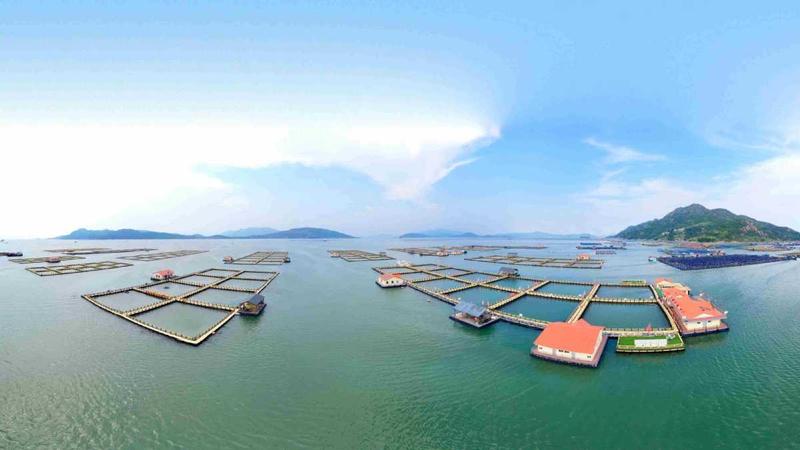 An aerial view of an ocean farm where large yellow croakers are raised in Sandu Bay, Ningde, Fujian province. (JIANG KEHONG / XINHUA)
An aerial view of an ocean farm where large yellow croakers are raised in Sandu Bay, Ningde, Fujian province. (JIANG KEHONG / XINHUA)
At 6 am every day, 57-year-old You Weide steers a boat to a floating house on the sea and scatters fish feed across the surface of the water that is divided by lines of plastic planks. A shoal of fish rises and takes elegant bites.
Set in the middle of tranquil Sandu Bay in Ningde, in the eastern province of Fujian, is one of the millions of ocean farms in China that produce nearly two-thirds of the world's cultivated seafood, according to fishery authorities.
If you open Google Earth and zoom in, you will see floating farms virtually everywhere along China's coastline. That is how Chinese families can afford a range of seafood such as fish, shrimps, clams and crabs for their daily meals.
You raises large yellow croakers, one of the four major ocean fish in China in terms of the number produced and eaten.
In some coastal regions, it is traditional for children to visit their maternal grandparents during Dragon Boat Festival carrying two large yellow croakers as gifts.
The large yellow croaker, which once thrived in the shallow seas and estuaries along the coastal provinces, was nearly fished to extinction in the 1970s. Decades later, the number of the once-endangered species is close to its old peak, thanks to artificial reproduction efforts by Liu Jiafu, a grassroots aquaculturalist.
The revival of the fish stock not only helps villagers shake off poverty in Ningde, once an impoverished area, but also feeds the increasingly prosperous population's appetite for quality food-a long-standing challenge in China.
 Liu Jiafu, a grassroots aquaculturalist, looks up information online. (JIANG KEHONG / XINHUA)
Liu Jiafu, a grassroots aquaculturalist, looks up information online. (JIANG KEHONG / XINHUA)
Youthful interest
Born in a fishing village on the rugged coastline of Fujian's Lianjiang county, Liu developed a keen interest in the yellow croaker at a young age while helping his father on the sea.
In 1964, in a feat that was rare for a rural resident at the time, Liu was admitted to the Shanghai Fisheries College, majoring in fishery resources. When he graduated in 1971, he was appointed as a data collector in Lianjiang and was responsible for locating fish resources.
He was glad to help his home fleet land huge catches through information he collected from fishermen and marine dealers.
The joy did not last long. In 1973, over 3,500 pairs of motorized sailboats gathered in the waters off the Zhoushan Archipelago in the eastern province of Zhejiang to catch overwintering yellow croakers.
That winter, the boats caught 250,000 metric tons of the fish, more than twice the normal number in China. No schools of the fish ever came to the area again.
Liu became worried about the ever-dwindling numbers of yellow croakers. In 1979, his fears were exacerbated when ships from several coastal provinces ravaged the waters of Sandu Bay, a natural spawning ground for the fish, and caught 60,000 tons.
In about 1980, with fish numbers severely depleted, the survival of the species was in question.
Liu became determined to save the fish through captive breeding, even though most aquaculturists considered it an impossible task, given that the yellow croaker is a migratory species that lives in mid-range and deep waters.
"It was painful to witness the disappearance of the croaking fish, and I was probably like a snowflake in an avalanche," Liu said. "I felt an obligation to prevent their extinction."
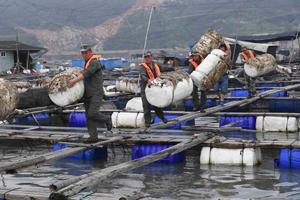 Workers collect old floats at yellow croaker farms in June as part of efforts to upgrade facilities. (JIANG KEHONG / XINHUA)
Workers collect old floats at yellow croaker farms in June as part of efforts to upgrade facilities. (JIANG KEHONG / XINHUA)
A fresh start
He had to start from scratch. First, he learned how to induce spawning, inseminate fish eggs and hatch fries at local freshwater fish farms, while studying books about the artificial propagation of saltwater fish. Meanwhile, he surveyed the spawning grounds in Sandu Bay to study the behavior of the fish.
With 10,000 yuan allocated by the provincial fishery department, the Large Yellow Croaker Artificial Propagation Project was officially launched in 1985.
In a spawning induction experiment on May 9, 1987, more than 100 large yellow croaker fries hatched from 20 adult fish caught in the wild.
But experts and fishermen did not envisage great prospects for the artificially preserved species because the fish grew slowly and so were not suitable for commercial farming. The project was shut down, and once again Liu was pushed into a corner.
Despite scant research funding and doubts expressed by other experts, Liu borrowed money from friends and established an aquaculture technology extension lab to study farming methods for large yellow croakers.
"We lived and worked on an old boat bought from a local fisherman because we could not afford a brick-and-mortar house. We used bamboo canes as makeshift water pipes to save money," Liu said.
Despite those issues, by 1995, the team had solved the problem of slow growth and developed the whole process of cage farming, which laid the foundations for mass commercial farming of the fish. Liu immediately set out to promote cage farming of large yellow croakers.
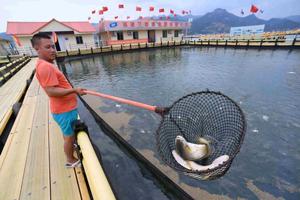 A worker uses a net to catch three large yellow croakers. (JIANG KEHONG / XINHUA)
A worker uses a net to catch three large yellow croakers. (JIANG KEHONG / XINHUA)
Out of poverty
You was one of the first farmers to reap the fruits of Liu's efforts. The oldest son of a rural family in Sandu Bay, he had to drop out of school at age 13 to support his family by selling popsicles in the sweltering sun.
"We could barely get by 30 years ago because the sea had run out of fish and there was very little arable land in our village," he said. "All we had to eat were slices of dried sweet potato."
In the early 1990s, he dug a pond in the village to raise eels. He was devastated in 1996 when all the eels swam away during a flood caused by typhoon rains, leaving him more than 3 million yuan in debt.
The desperate farmer turned to Liu for help when he heard that raising large yellow croakers had become a cash cow thanks to technological breakthroughs. Liu sent his best assistant to You's fish farm for a year to teach him every detail of the process.
In 1997, You began farming the fish. His business quickly picked up and he managed to pay off all his debts within a year.
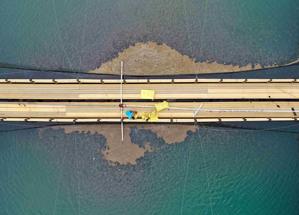 A member of staff feeds large yellow croakers last month. (JIANG KEHONG / XINHUA)
A member of staff feeds large yellow croakers last month. (JIANG KEHONG / XINHUA)
Now, he is a leading figure in the large yellow croaker industry, owning three companies whose activities range from hatching fries to the breeding and processing of yellow croakers. The companies produce 8,500 tons of the fish every year.
Many farmers followed suit and the local government listed it as a pillar industry of the local economy, offering technical support for farmers and subsidies for downstream manufacturers.
After decades of development, Sandu Bay, once depleted of large yellow croakers, is one of the world's biggest aquafarming hubs, helping tens of thousands of people to shake off poverty.
Last year, overall production of large yellow croakers reached 164,000 tons in Ningde alone, accounting for about 83 percent of the country's total and creating over 300,000 jobs in fish farming and supporting industries.
In 2014, Liu retired from local aquaculture extension services at age 74, but he is as busy as ever, answering fish farmers' questions during training sessions or on the phone.
"I am always ready to answer questions about the techniques for farming large yellow croakers because I hope my research will benefit as many people as possible," he said.
Feeding the nation
Liu is delighted that his breeding practices-such as feeding fingerlings small crustaceans and using eugenol as a cheap, easily available anesthetic-have been extended to the farming of other marine animals and even freshwater fish.
With the boom in aquaculture across the country, China has become the world's largest producer and consumer of seafood, and the only country to produce more seafood in fish farms than in the wild.
Chinese people eat nearly 65 million tons of seafood every year, accounting for 45 percent of global consumption, with more than 50 million coming from floating farms.
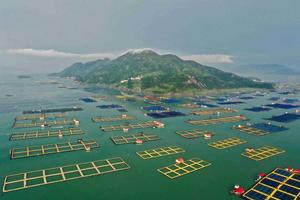 An aerial view of ocean farms. (JIANG KEHONG / XINHUA)
An aerial view of ocean farms. (JIANG KEHONG / XINHUA)
While the large yellow croaker has once again become one of the most popular dishes on tables in China after decades of commercial farming, Liu dedicates himself to improving the industry to produce higher-quality fish for the burgeoning middle class.
On his advice, local governments have been helping fishermen replace existing breeding cages with larger ones so the fish can grow stronger and healthier.
"There is more room for them to swim and exercise in big cages, which are usually 100 square meters and 8 meters deep," Liu said. "Fish that live in small cages, which are 9 square meters, can suffer from overcrowding and have unwanted fat on their bodies because of lack of exercise."
In recent years, some large yellow croaker farms have moved from the safety of the bay to the open sea. Earlier this year, a semi-submersible fish farm was installed in the waters 30 nautical miles off the coast of Ningde as a trial run to farm large yellow croakers in the open, sometimes choppy waters.
The giant pie-shaped cage, which is 140 meters in diameter and 12 meters in depth, provides a farming space of over 150,000 cubic meters to simulate the living environment in the wild.
At the age of 80, Liu still dreams big: to make the large yellow croaker a global dish like the salmon.
"We produce 200,000 tons of large yellow croaker every year, while the production of the salmon industry stands at 2 million tons," Liu said. "There is still a lot of room for our fish in terms of technical innovation and market expansion."
Liu has another dream. He is pushing to revive China's wild yellow croaker stocks by persuading local governments and aquaculture companies to release fry into the sea.
"Preserving the genetic resources is just the beginning. I do not want to brag about it," Liu said. "The ultimate goal is to restore stocks in the wild."
He is writing a book, preliminarily called A Brief History of Fishing and Farming the Large Yellow Croaker, which details his life taking care of the fish.
Now, he is looking for a happy ending for his book.



